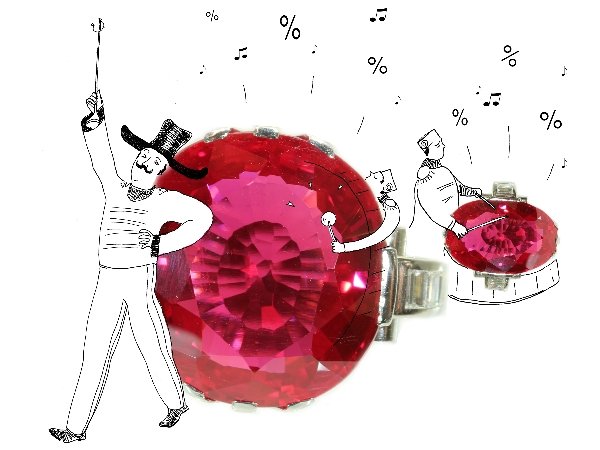Nu gespreide betaling mogelijk op het juweel van uw dromen! Vraag ons naar de details. Gratis verzekerde verzending van alle orders!
Weekly Antique Jewelry Herald (archive 2016)
The entire Adin team is toasting
to your good health!
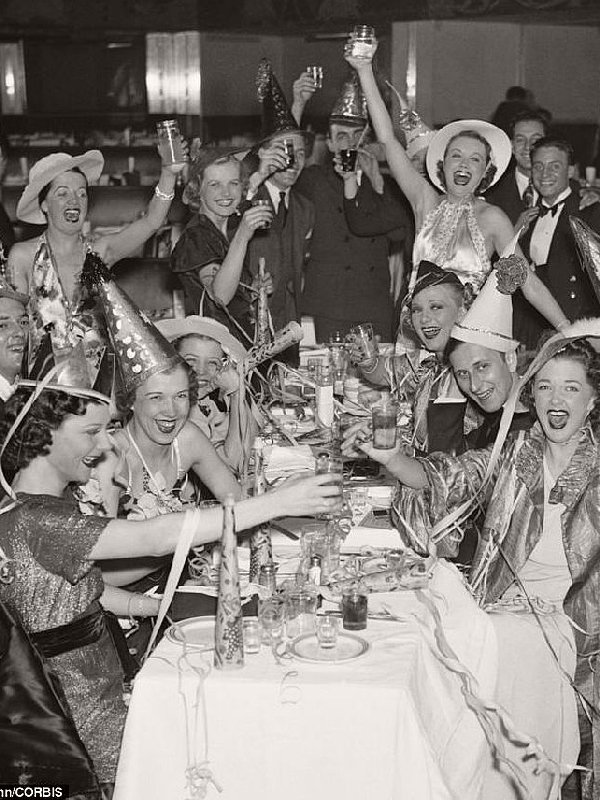 Click the picture to see the antique jewelry our team has gathered. |
To our customers!
Who have the great taste
to call upon our antique jewelry expertise.
Happy New Year!
Adin Fine Antique Jewellery Information
The Whiplash
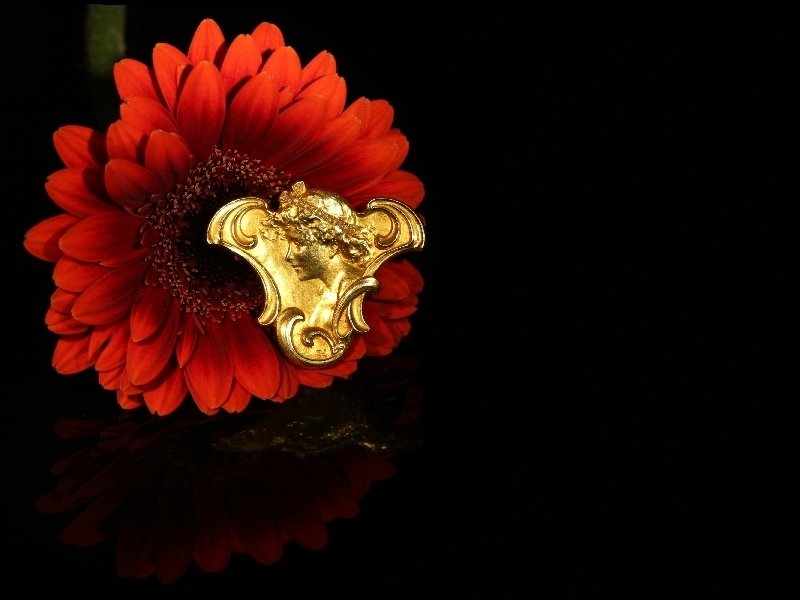 |
The Whiplash
A touch of history ...
Although Art Nouveau (1880-1914) took on distinctly localised tendencies as its geographic spread increase some general characteristics are indicative of the form. A description published in Pan magazine of Hermann Obrist's wall-hanging Cyclamen (1894) described it as "sudden violent curves generated by the crack of a whip", which became well known during the early spread of Art Nouveau.
Subsequently, not only did the work itself become better known as The Whiplash, but the term "whiplash" is frequently applied to the characteristic curves employed by Art Nouveau artists. Such decorative "whiplash" motifs, formed by dynamic, undulating, and flowing lines in a syncopated rhythm, are found throughout the architecture, painting, sculpture, and other forms of Art Nouveau design. (Source: Wikipedia)
For more information, please click the picture and find the full explanation at the descriptive page of this fine jewel.
Adin Fine Antique Jewellery Information
Dummy Jewellery
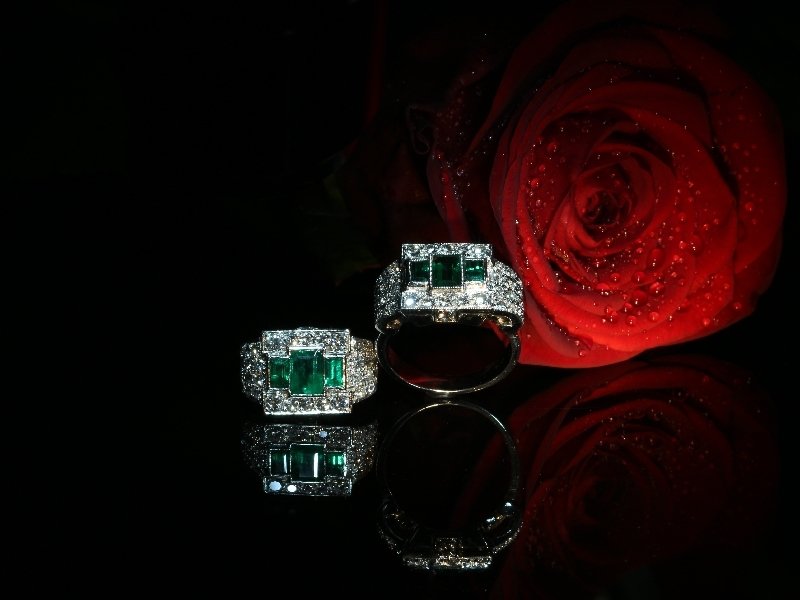 |
Dummy jewellery
A touch of history ...
At first, we thought we were seeing double but immediately we realised how exceptional this pair of rings really is. Not only have we got a most valuable platinum Estate ring with high class Colombian emeralds and diamonds, but also its dummy.
Up to the Fifties of the last century it was not uncommon for the happy few to have their most precious jewellery pieces reproduced in less expensive materials. These reproductions were called "dummies" and were specifically made to wear during flamboyant cruises and extensive journeys. Nowadays, such pairs are hardly being found as a couple anymore which makes of this valuable ring together with its pseudo-twin truly a unique collection.
Although the terms "dummy" and "copy" are no flattering words for any meticulously crafted jewel, make no mistake: it's only the original ring's counterpart that embodies the most precious adventures of its owner.
For more information, please click the picture and find the full explanation at the descriptive page of these fine jewels.
Adin Fine Antique Jewelry Information
'Belle Époque' Jewelry
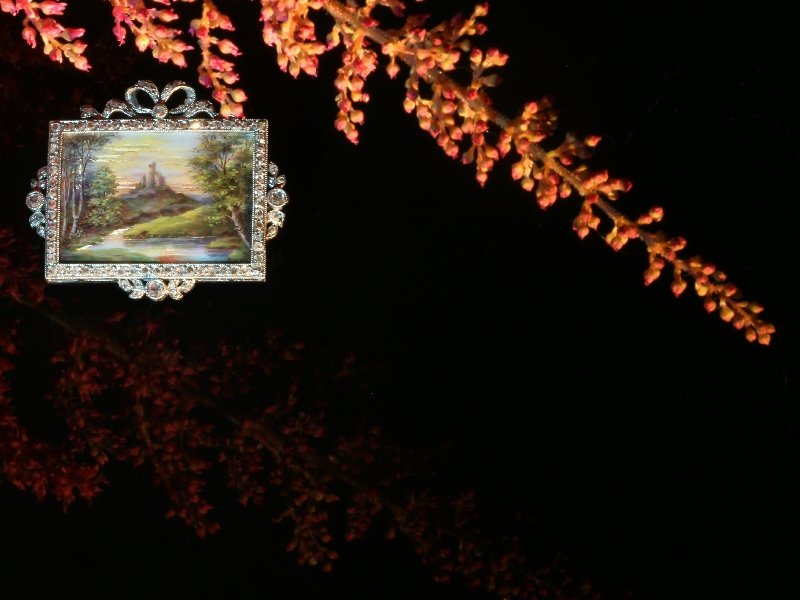 |
Belle Époque
A touch of history ...
As was aspired in the true existence of the Belle Époque period, this enchanting brooch from 1900 embodies the glorification of romanticism perfectly. The gleam of the parallel engravings -called guilloche- in the 18K warm yellow and possibly red gold background lures you straight from the platinum frame of 104 rose cut diamonds into its nostalgic enameled landscape. Over the sun-kissed meandering stream, you can drift off to a long forlorn ruin while passing spring blooming trees in green meadows.
With its ribbon and double twig wrapping, this marvelous jewel presents more than only the framework in which your past memories reflect next to your future dreams. The depth that is being created and how the scenery comes to life by the sun's reflection on the water show the craftsmanship of a master goldsmith ánd painter. In our trade, we treasure such an extraordinary craft, where the gold shines through the transparent and translucent enamel.
For more information, and see the actual shining of the scenery that we are so amazed by, please click the picture and find the full explanation and movie at the descriptive page of this fine jewel.
Adin Fine Antique Jewelry Information
'Style Guirlande' Jewelry
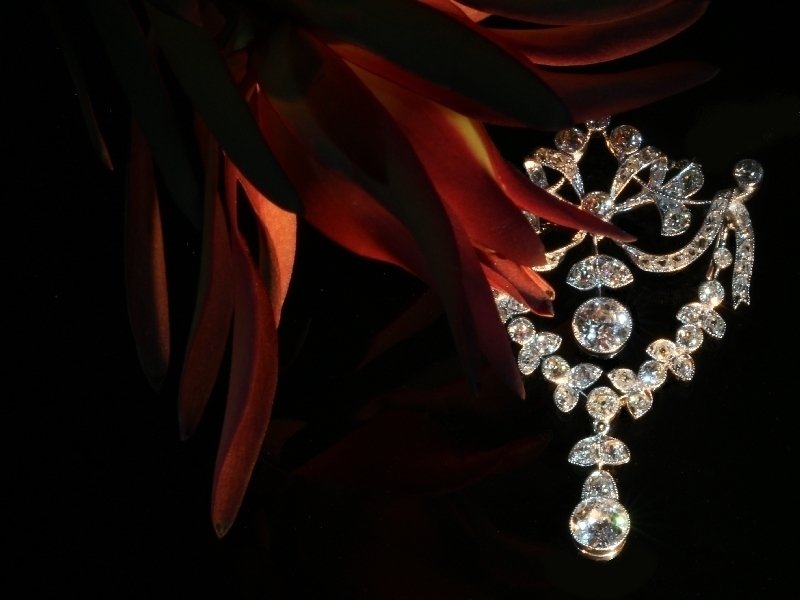 |
Style Guirlande
A touch of history ...
The Belle Époque Style is also called 'Style Guirlande' (French) or in plain English: 'Garland Style'. In this era, delicacy was the desired fashion through the use of white metals and white stones shaped in a garland design. Motifs of ribbons and bows, leafs and flowers predominated in symmetrical curvy openwork shapes according to the example of renaissance garland paintings and of the frothiness of the 18th-century rococo patterns.
As a truly extraordinary example from its era, this antique platinum pendant glistens through the 76 diamonds encrusted in the joyfully arranged leafs. From the upper triple diamond top, two leaflets sprout downwards through both nooses of the central bow from which two ribbons drape over the two twigs. The bow’s heart suspends a dangling old European cut diamond, which chaperones your gaze to two arching garland branches. At the point where they meet, another old European cut diamond sways from a pair of leaflets.
This charming scenery swoops anyone to moments of merry and bliss. For more information, please click the picture and find the full explanation at the descriptive page of this fine jewel.
Adin Fine Antique Jewelry Information
True love lasts forever!
(400 years old and still very wearable)
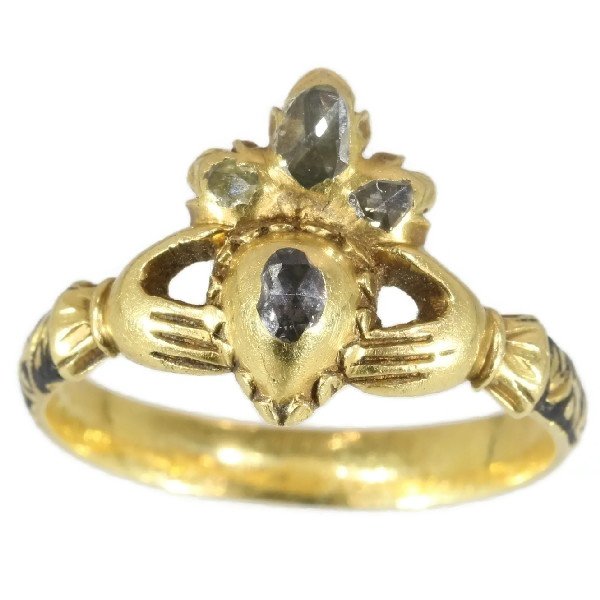 |
Love Symbolism
A touch of history ...
Dating back from around 1630, this 18K yellow gold ring -called a Claddagh ring or Fede ring- is truly a present from history and tales. Two hands offer friendship by reaching out a heart which is bulging -or better bursting- from love through the gleam of a foil-set rose cut diamond. To seal this bond with loyalty, a crown with three rose cut diamonds in a foilsetting guides the heart vertically around your finger. Looking at the untouched black enamel on the sleeves behind the gold hands, this precious jewel proves to stand the test of time. As should the union between the two loved ones who share this treasure.
To find a more genuine relic is nearly impossible as it seems that the GIA museum, Carlsbad, USA, has got one other example of a Claddagh ring in this specific design from the 17th century. Having this jewellery piece in your possession, it is definitely more of an honour than a hazard to preserve and even wear this rare fragment of history.
An almost identical item from a private collection can be found in the book titled “Rings: Jewelry of power, love and loyalty” by Diana Scarisbrick, Thames & Hudson Ltd London 2007, and in the book titled “Rings: Symbols of wealth, power and affection” also by Diana Scarisbrick, Thames and Hudson Ltd London 1993.
The astonishing resemblance between the catalogued rings and this exceptional ring confirms once more the remarkable age of this ring and the miracle of its well-guarded travel through time.
For more information, please click the picture and find the full explanation at the descriptive page of this fine jewel.
Adin Fine Antique Jewelry Presents:
Vintage earrings with the refreshing scent of eucalyptus!
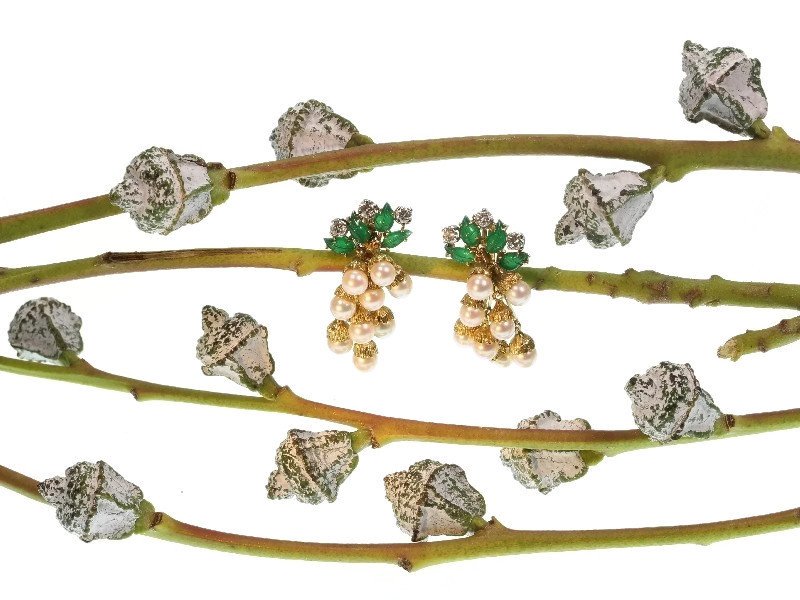 |
Antique Jewelry Magician Strikes Again!
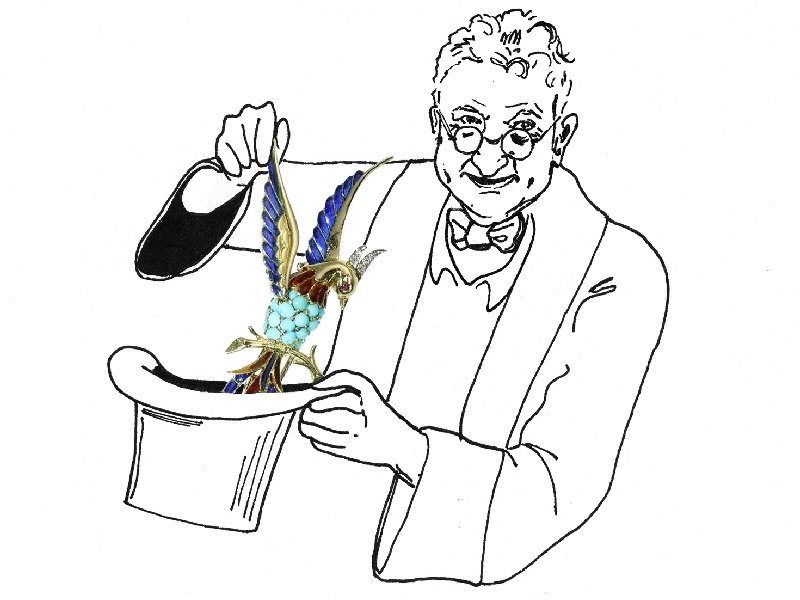 |
Adin Circus Is Still In Town !
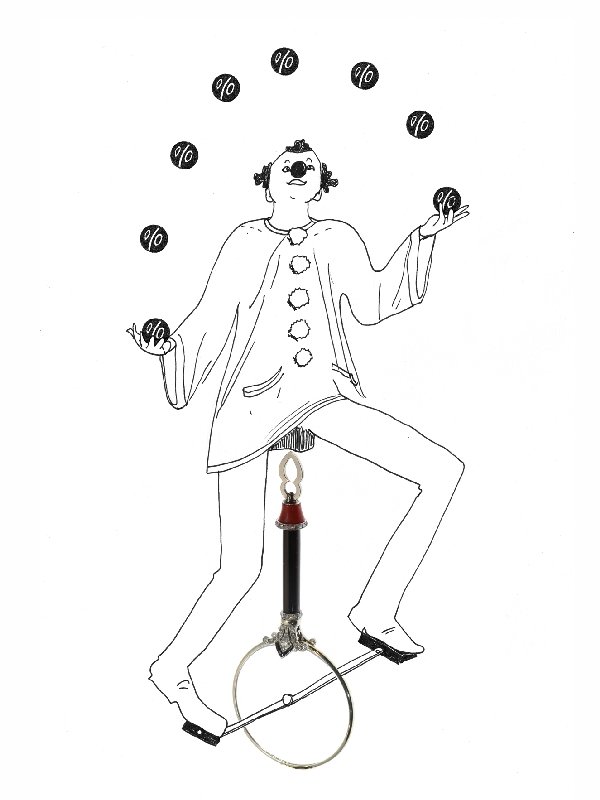 |
Mutant Pumpkin Spotted
Guarding the Gates of Adin Antique Jewelry!
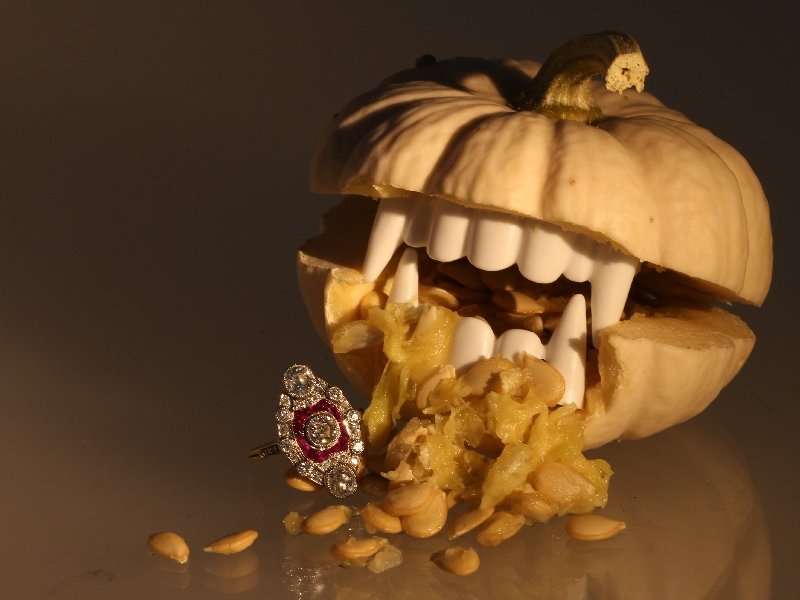 |
Halloween at The Garden of Adin
Who needs orange to have a nice Halloween?
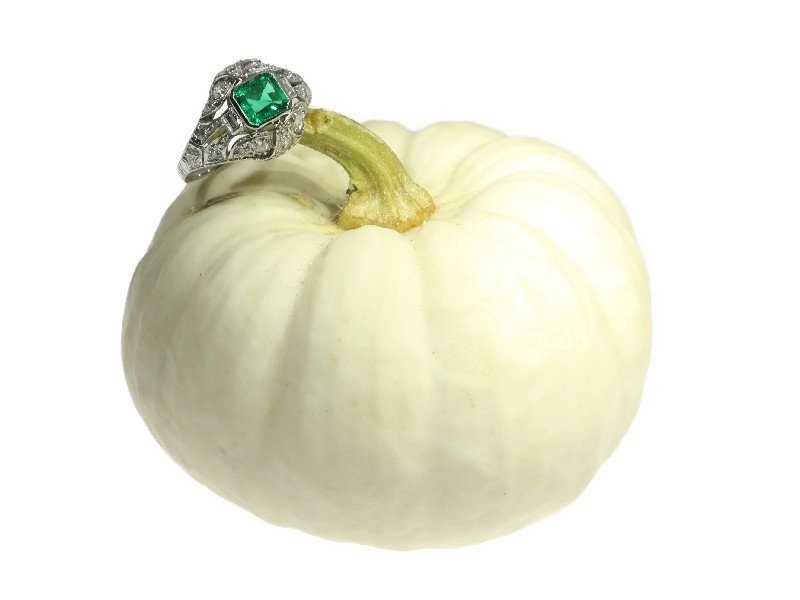 |
The Garden of Adin Wishes You:
A Colorless Halloween!
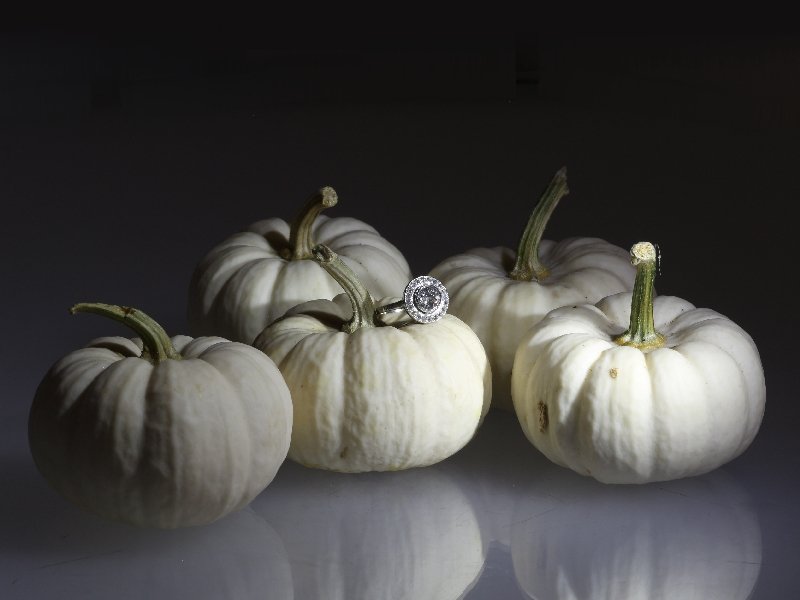 |
Adin Fine Antique Jewelry Presents:
Exuberant parure with over 34 carats of diamonds!
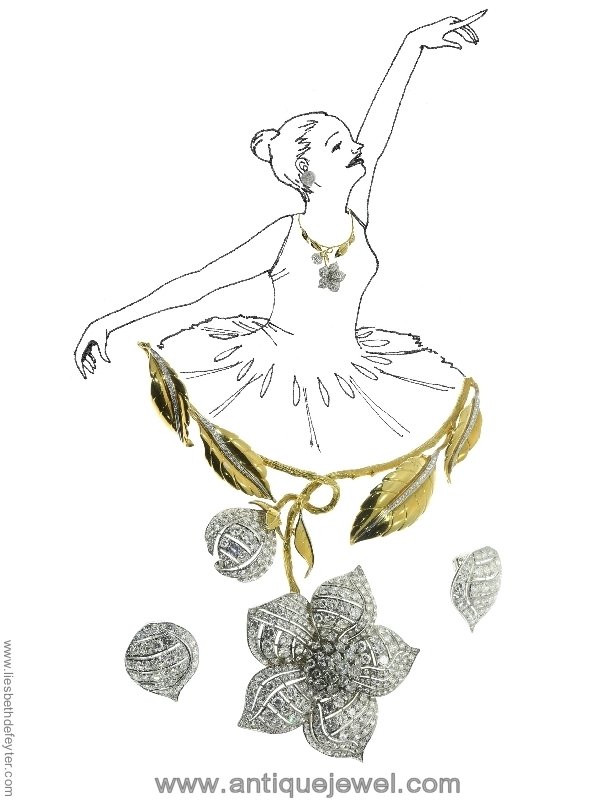 |
A Parure
A touch of history ...
Here we have what we call in our trade a "parure". A parure is a matching set of jewellery, meant to be worn together. This particular set of earrings and necklace with a pendant changeable into an independent piece truly seems to be bejewelled by a force of nature, which will make you as enticing as a divine nymph.
With a swirl of 18K yellow gold branches, this exuberant Dutch Estate necklace alights its azure-set 275 brilliant cut diamonds of a total of over 34 carats sprouting from an 18K white gold bloom, flower bud and leaf veins effortlessly around your neck.
Not to mention the two petal-shaped earclips with each 61 brilliants in an overall recurring pattern of horizontal and vertical pierced white gold millegrain rims, that are meant to be whisked to your ears by a spring breeze.
Especially to fit your every need, the tremendous floret of this striking set from 1990 can be picked from its sprig to wear it as a brooch or separately as a pendant on a twisted silk cord in the colour of your choice. The possibility not to just flaunt your exquisite style but also to have fun with dressing up and anticipating your moment of shine is offered by the assortment of the eight silk strings, each in a different colour: there's black, silver, metallic, navy blue, apple green, cinnamon and chocolate brown to play with.
For more information, please click the picture and read the full explanation at the descriptive page of this fine jewel.
Adin Fine Antique Jewelry Information
Symbolism in Antique Jewelry.
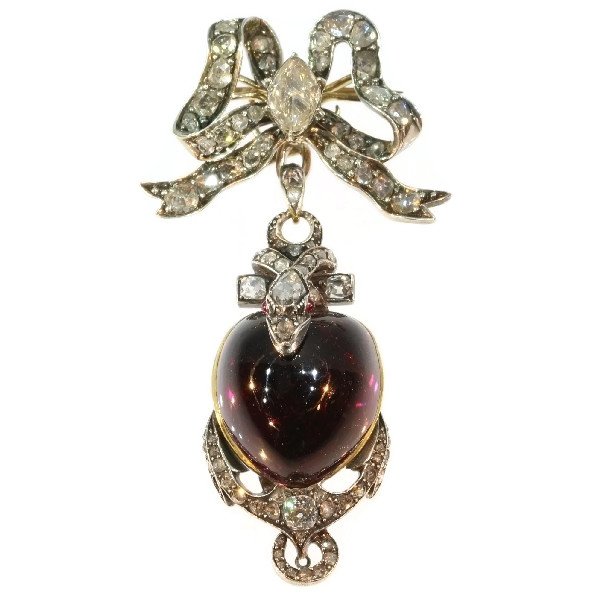 |
Symbolism
A touch of history ...
This Early-Victorian bi-colour gold-backed pendant from 1830 embodies a treasure of symbols through a deep pink garnet heart, a silver-topped bow, snake, cross and anchor encrusted with three European cut diamonds and with a total of 86 rose cut diamonds set in foil.
While the ruby-eyed snake wraps around the cross, its head emerges to the centre of the garnet and emphasizes the opulent heart-shape. This meaningful composition reveals the snake's role of protection, wisdom, hope and fertility when it comes to matters of the heart from deep within the garnet's core. This gemstone of love is topped by a cross which extends from behind the garnet into an anchor, resulting in an Anchored cross or also called a Mariner's cross. Generally signifying hope, this bejeweled imagery contributes even more to the message of promise and faith in this jewel.
To complete the message of hope and tenderness, the above-mentioned piece with a 14K yellow gold back dangles from an adorable bow-knot with an 18K red gold back which literally depicts the strong bond of love. This bow particulalry grants you the possiblity to even wear this extraordinary jewellery piece as a brooch.
It couldn't be more clear from the craftsmanship and the total design that this jewel doesn't just speak of promises and fairytales, but it truly achieves to convey the message of love.
For more information, please click the picture and read the full explanation at the descriptive page of this fine jewel.
The Garden of Adin
New Species of Dragonfly Discovered!
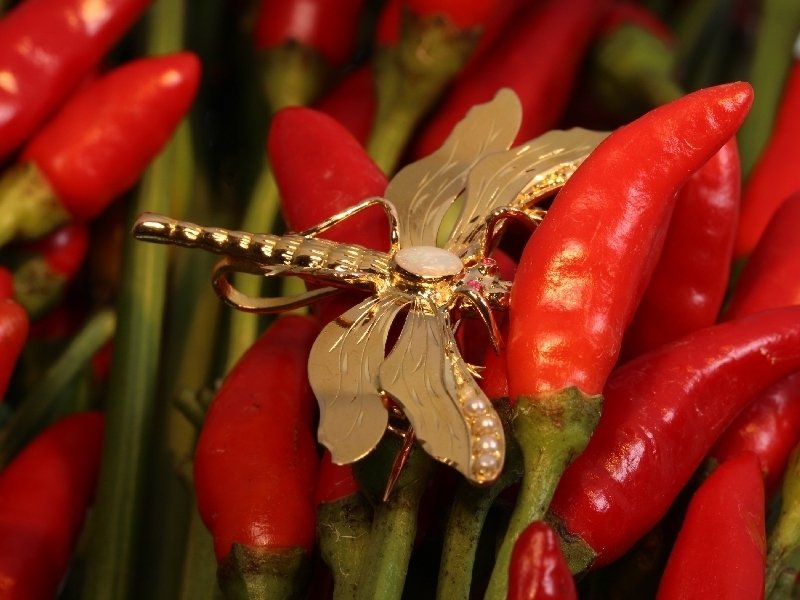 |
Adin, Antwerp Belgium - The newfound species is about 1.3 inches (3.4 cm) long. It lives close to mountain streams in a remote region in The Garden of Adin. So far, only gold specimens are known; with an opal body, pearl spots and ruby eyes.
The species is named Stultitia Elkanti, in honor of Prof. Elkan Wijnberg, Chief biologist at the Garden of Adin. “Having a newly discovered animal or plant species named after oneself is one of the most beautiful awards for a biologist,” Prof. Wijnberg commented. “I’m extraordinarily honored, for sure, but there are a lot of other dragonfly researchers who would have deserved this award before me.”
Research describing the new species is published online in the Adin Weekly Herald.
Adin Antique Jewelry Games 2016
Closing Ceremony by Cirque d'Oreille!
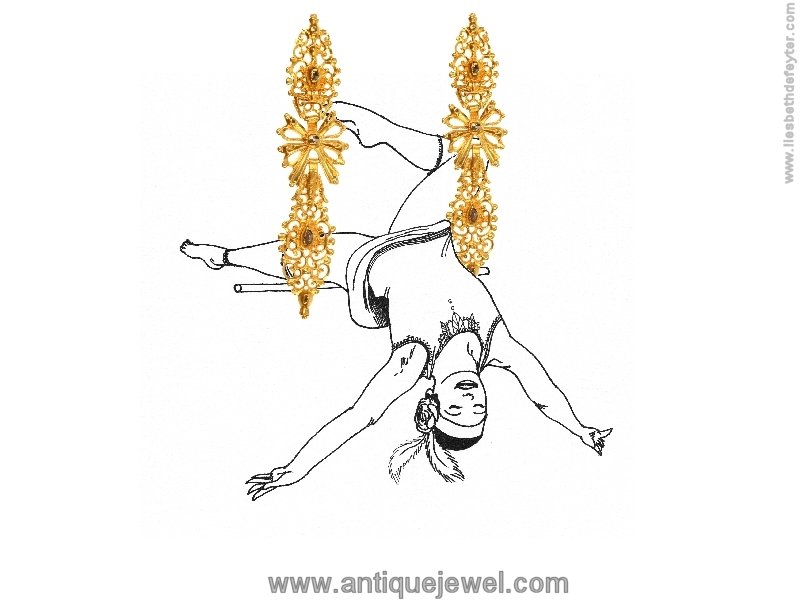 |
Magnificent Antique Jewelry Inspired Performance
ANTWERP, Belgium (AAJ) - Antwerp’s globally celebrated cultural icon, Adin's Cirque d'Oreille, is bringing its special blend of stagecraft, thrilling acrobatic athleticism and colourful cultural pageantry to an original production created especially for the Closing Ceremony of the Adin Antique Jewelry Games 2016.
Adin Antique Jewelry Games 2016
Survey: athletes very satisfied with bedroom facilities!
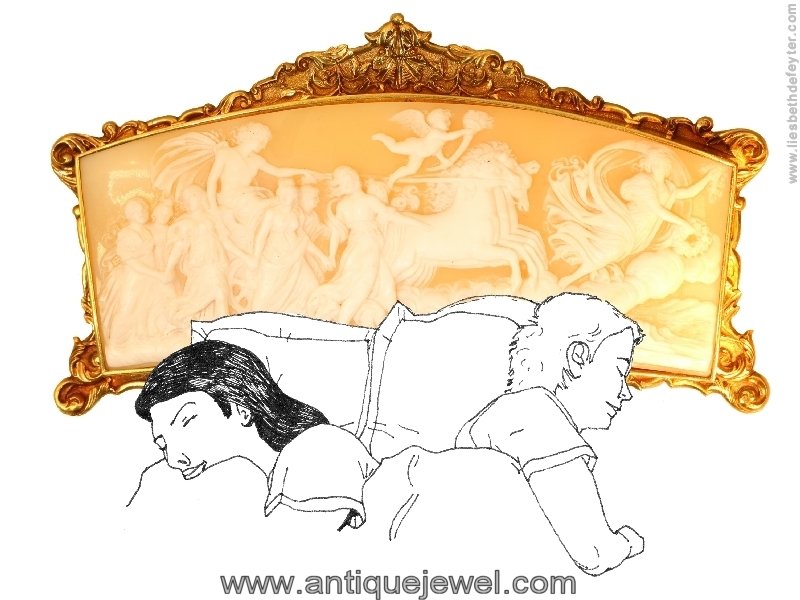 |
Athletes sleep better because of Antique Jewelry.
ANTWERP, Belgium (AAJ) - They call Elkan Wijnberg 'the dream expert'. A veteran of over thirthy Antique Jewelry Games, the experienced official is working on the biggest challenge of his career: managing the decoration of the athletes sleeping facilities.
“With the addition of our new antique jewelry frame we’re making it even easier for the athletes to relax.” says Wijnberg, who formerly served as gardener in The Garden of Adin. “Although a recent study showed that most of the people sleep with their eyes closed, we still want to bring that extra touch to the quality of their night rest."
Adin Antique Jewelry Games 2016
New Sport Approved For Antique Jewelry Games 2020
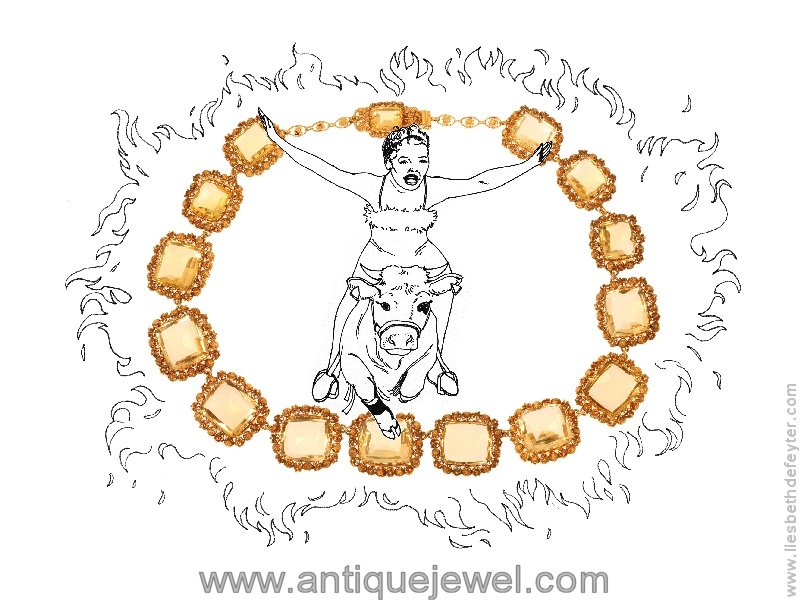 |
Cow Jumping
The International Antique Jewelry Games Committee (IAJGC) today agreed to add Cow Jumping to the sports program for the Adin Antique Jewelry Games Antwerp 2020.
The decision was the most comprehensive evolution of the Antique Jewelry Games program in modern history. Plans call for staging Cow Jumping in temporary venues installed in urban settings, marking a historic step in bringing the Games to young people and reflecting the trend of urbanisation of sport.
Adin Antique Jewelry Games 2016
Synchronized Antique Jewelry Swimming
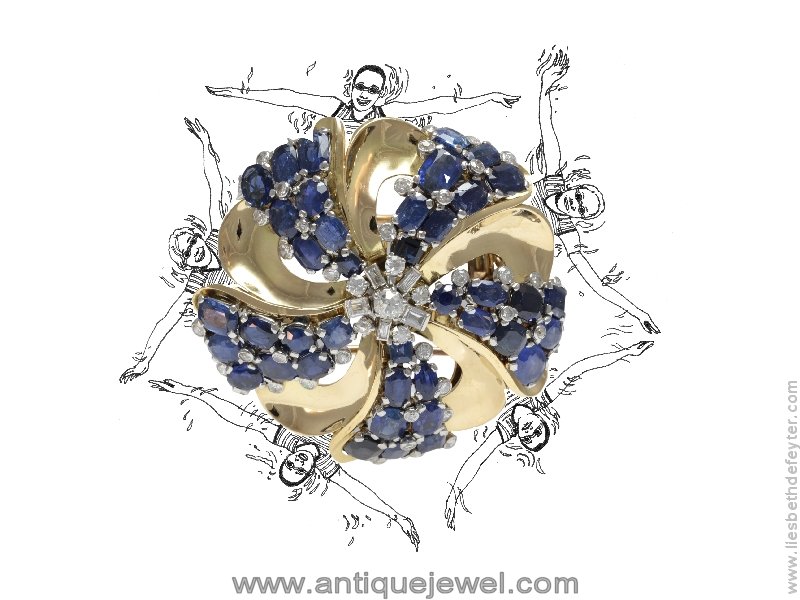 |
5th Consecutive Gold Medal For Adin!
The free routine final for synchronized antique jewelry swimming of the Antique Jewelry Games 2016 was highlighted by a near perfect routine by the Adin antique jewelry swimming team.
Talking to the media afterwards, Adin synchronized antique jewelry swimming team trainer Mr. Elkan Wijnberg commented that “sometimes everyone calls the girls mermaids and asks if they have gills, it's that comfortable they are in this performance.”
The Adin Team’s gold medal performance further solidified Adin's dominance over the sport of synchronized antique jewerly swimming bringing home Adin’s fifth straight gold medal.
Adin Antique Jewelry Games 2016
NEWSFLASH: NEW WORLD RECORD!
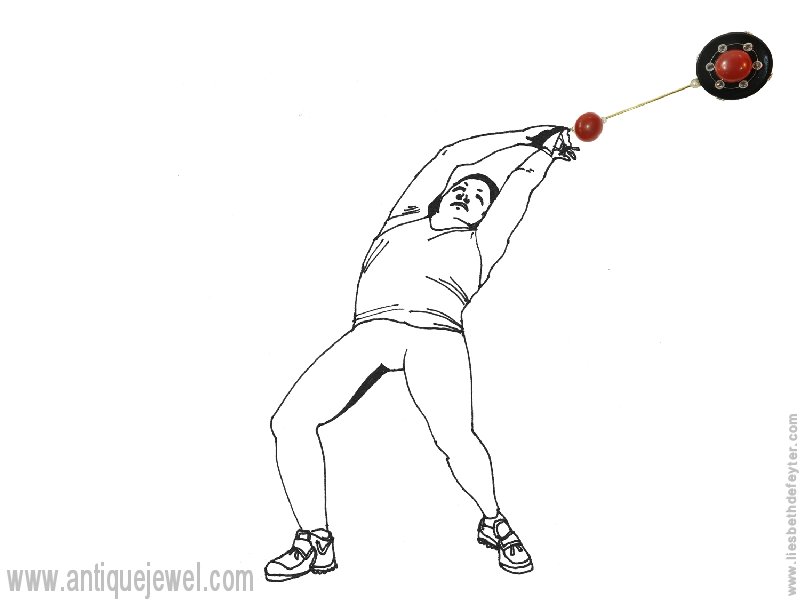 |
Jabot Pin Throwing
ANTWERP, Belgium (AAJ) - Adin's top athlete Elkan Wijnberg smashed his own world record on his way to victory in the jabot pin throw today!
Widely regarded as the greatest men's jabot pin thrower of all-time, Wijnberg heaved a monumental distance on his third attempt to crush the competition at the Adin's Antique Jewelry Stadium.
Wijnberg's winning effort was more than one metre further than his own previous world record set in 2015.
Adin Antique Jewelry Games 2016
Are Officially Opened!
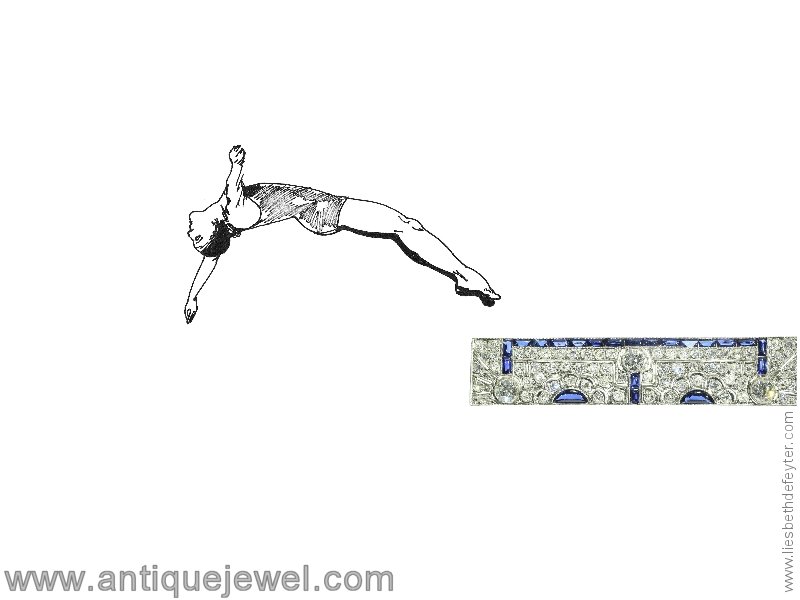 |
Art Deco Jewelry Diving
Art Deco Jewelry Diving as independent part of Antique Jewelry Diving was first introduced in the official program of the Adin Antique Jewelry Games at the 1904 Games of Antwerp and has been an Antique Jewelry sport since. It was known as "fancy diving" for the acrobatic stunts performed by divers wearing impressive antique jewelry during the dive (such as tiaras and full parures).
This discipline of Aquatics, along with bejeweled swimming and water pearl polo, is regulated and supervised by the international federation for aquatic antique jewelry sports.
Summertime In The Garden of Adin
And the livin' is easy...
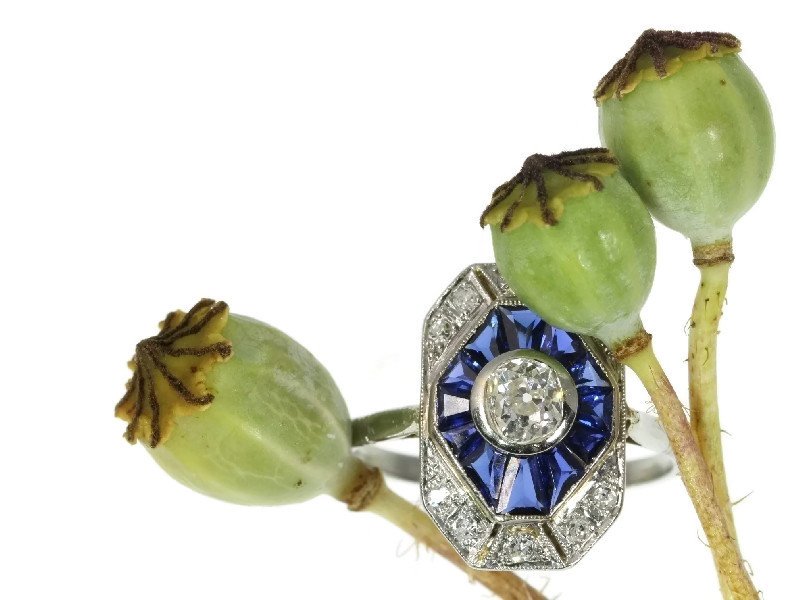 Click the picture to read about this estate Art Deco ring. |
Art Deco
Abstract motives and geometrical forms are quite typical for the Art Deco period. Art Deco moved away from the soft pastels and organic forms of its style predecessor, Art Nouveau, and embraced influences from many different styles and movements of the early 20th century, including Neoclassical, Constructivism, Cubism, Modernism, and Futurism.
Its popularity peaked in Europe during the Roaring Twenties and continued strongly in the United States through the 1930s. Although many design movements have political or philosophical roots or intentions, Art Deco was purely decorative.
Summertime In The Garden of Adin
And the livin' is easy...
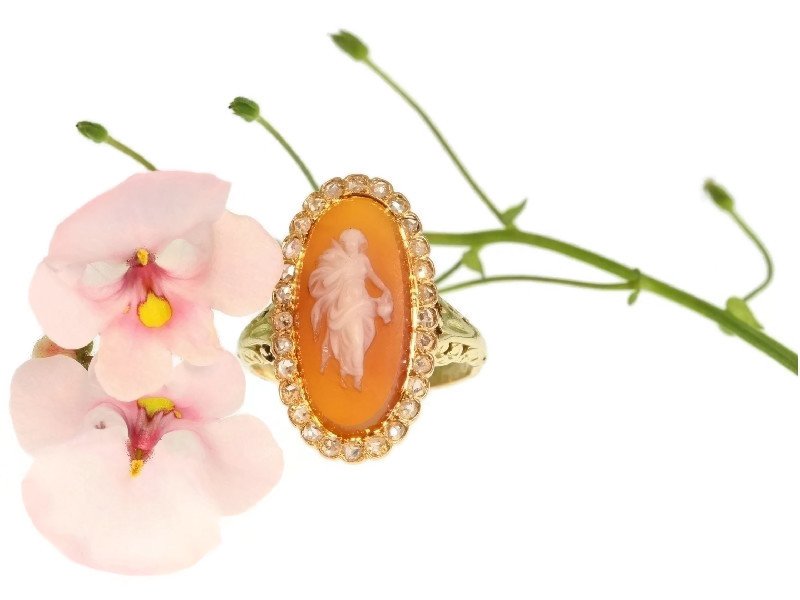 Click the picture to read about this antique diamonds and hardstone cameo ring. |
Cameo
Cameo is a method of carving, or an item of jewellery or vessel made in this manner. It features a raised (positive) relief image. There are three main materials for Cameo carving; Shells or Agate (called a Hardstone cameo), and glass.
Cameos can be produced by setting a carved relief, such as a portrait, onto a background of a contrasting colour. This is called an assembled cameo. Alternately, a cameo can be carved directly out of a material with integral layers or banding, such as (banded) agate or layered glass, where different layers have different colours. Sometimes dyes are used to enhance these colours.
Cameos are often worn as jewellery. Stone cameos of great artistry were made in Greece dating back as far as the 6th century BC. They were very popular in Ancient Rome, and one of the most famous stone cameos from this period is the Gemma Claudia made for the Emperor Claudius. The technique has since enjoyed periodic revivals, notably in the early Renaissance, and again in the 17th, 18th and 19th centuries.
French antique gold necklace with enamel
so-called collier d'esclave - ca. 1810
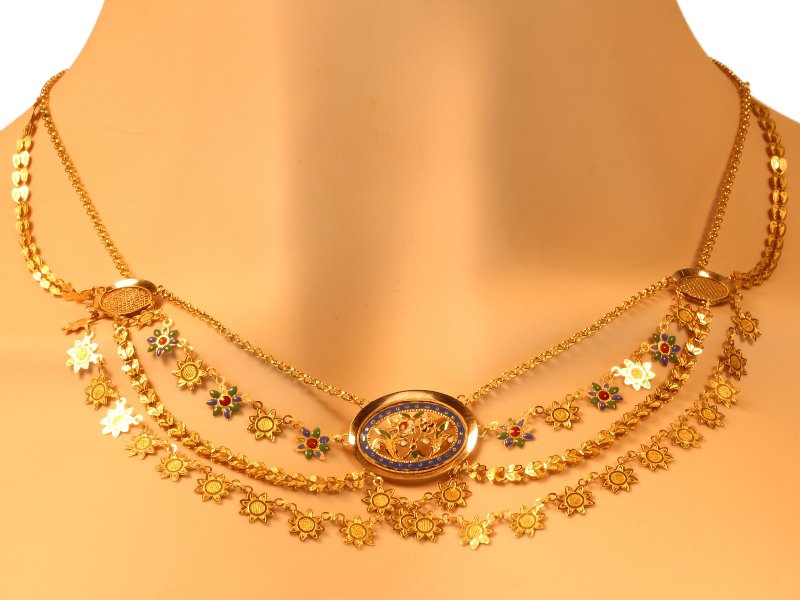 Click the picture to read about this French antique necklace. |
Collier d'esclavage
Esclavage is French and literally it means slavery. We'll leave it to your imagination to give an interpretation to this naming. It is a type of necklace composed of three or more chains or strings of beads or jewels in which the chains or strings hang approximately equidistant from each other. They were worn in Normandy as peasant jewelry in the mid-18th century. Such jewels were in many regions of France the most beautiful jewel offered by the bridegroom to his bride the day of their wedding. The definition of 'collier esclavage' appears for the first time in the 'Dictionnaire de Trévoux' in 1752. This necklace knows a very large geographical diffusion. In Normandy the gold pieces were often engraved. A collier d'esclave is an extremely rare article to find and we are proud to be able to offer one here.
Summertime In The Garden of Adin
And the livin' is easy...
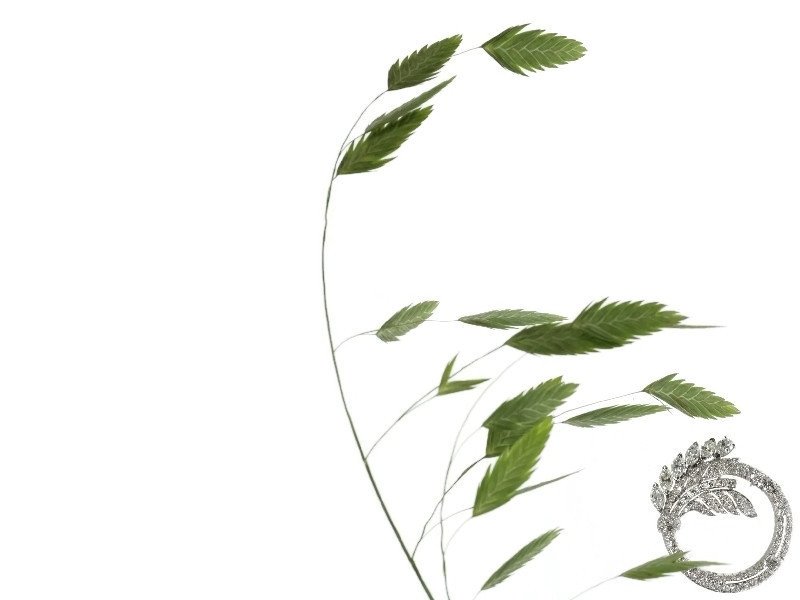 Click the picture to read about this Art Deco brooch. |
Truly magnificent Art Deco platinum diamond ring brooch
This platinum Art Deco brooch from 1930 resembles one of Cupid's arrows that is bending over backwards into an enclosed circle to find its goal. Imagine how the 182 ajour-set diamonds in various cuts will spark from the feather fletching over the bottom emerald cut diamond and back again when hitting your heart. The lustre of the marquise cut diamonds with the pear shaped one on top is only the beginning before they reach their goddess of love.
Summertime In The Garden of Adin
And the livin' is easy...
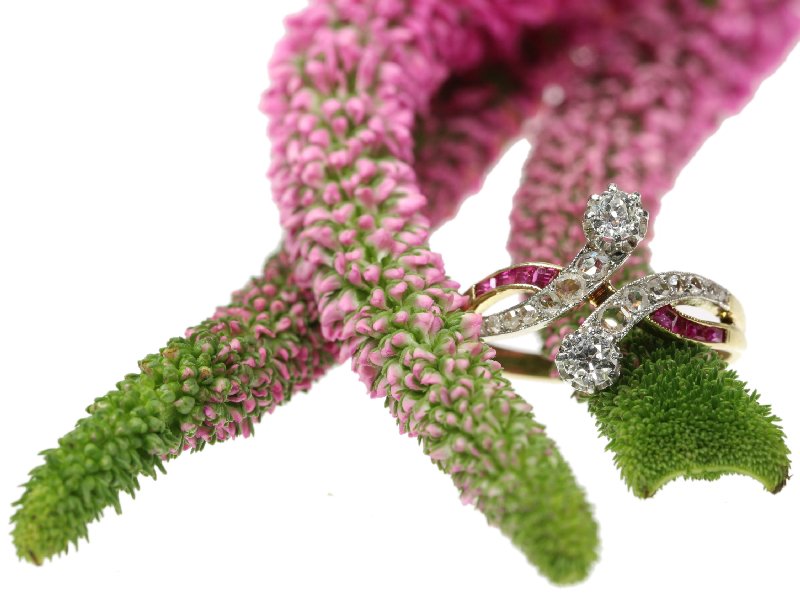 Click the picture to read about this Art Deco toi et moi ring. |
Adin Antique Jewelry presents:
A Clear Case of Oops!
(Errors and blunders from the world of jewelry.)
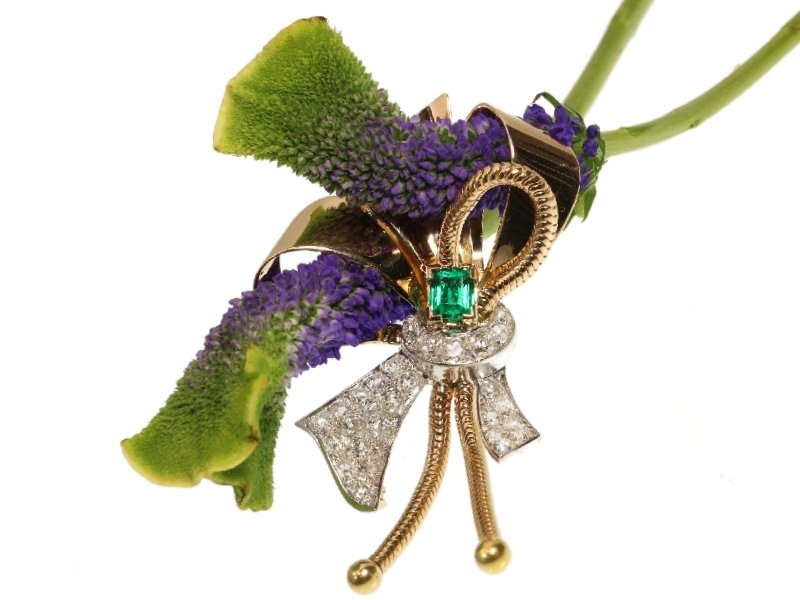 Click the picture to read about this Retro brooch. |
This week, in contrary to what you are used from us, we'll bring you something rather long to read. But we think you might enjoy it as much as we did.
We have an old friend (90+!) who comes from a respectable family of international precious stone and pearl dealers who could also count the shah of Brunei as customer.
This friend kept a diary of his vicissitudes and adventures and he recently gave us a copy. It turned out to be a very interesting read.
The following is one of those adventures....
A clear case of oops!
The year is 1943......
(Around the time the pictured brooch has been made)
When a foreign visitor goes ashore in Colombo the island of Ceylon, where by rights the very roads should be strewn with more gems than decorate the pages of the 'Thousand and One Nights' Entertainment, he is at once surrounded by a mob of evil smelling and noxiously persistent gem touts. Rudeness does not help at all in riding oneself of this nuisance, and I have known travelers who preferred staying on board during coaling time rather than face a small army of pestering gem vendors on shore.
On one of my periodical visits to the island I went ashore in company with several shipmates, and as usual the gem gang was there in full force to meet the passengers as they emerge from the ferry stage. In the twinkling of an eye, I and my friends were surrounded by a host of gesticulating, shouting natives, each more eager than the rest to introduce us to the amenities of the locality. As a side line these tourist guides all carried a supply of semi-precious stones, neatly done up in small paper packages, and –as of old– these thrust impetuously into our faces with invitations to inspect and buy.
This was all in good accord with certain deep-laid plans I had made while still aboard ship. After a moment, I exclaimed raising my voice to be head by first half a dozen and then by them all: “Look here, your fellows, if my friends and I really wanted to buy from you, you wouldn't let us! You won't let us budge. We can scarcely breathe. And as for looking at anything when a hundred of you show your goods at once, what a hope you've got! That's not the way to do business.”
This was not the talk they were accustomed to. After gaping at us for a moment they began to hustle us again, but a bit doubtfully this time. Then I said: “If you want us to inspect your goods, sit round in a circle, and we will take each of you in turn.” And they did it. After some scuffling and heated words, they actually formed themselves into a rough circle around us and I proceeded to inspect what each man held out in turn. Greatly wondering, they heard me recount in detail the manifold shortcomings of their stones. They could not make out at all the crazy white man who chose to sit in the broiling sun and who went to such pains to pronounce like an expert on their rubbishy goods.
When I thought that my chivvying had reached the limit of their patience, I drew from my pocket a magnificent sapphire, a rare specimen piece, from which I had long refused to be separated, despite most attractive offers. “Now, friends,” said I, “as you have shown me the best you have to offer, I will show you what kind of gem interest me, so that when I come again you will know what to bring me.” They all drew closer, but respectfully, for a good view of the stone in my hands, and those who managed to get a really good look broke into exclamations of astonishment.
“How much?” cried several with one voice. “Tell us what you want for it, mister. We know merchants in the town who will buy it from you.” For in the twinkling of an eye they were all brokers. “If I sell at all,” I replied firmly, “I will sell on the spot. Now, you boys know a good stone when you see one, as I can see, what about a deal with one of you?” At that there was a roar of laughter. A nimble-witted fellow called out: “yes, we will give you all we have got if you take sarongs in payment!” “Very well,” I said, “if you dealers won't buy, perhaps a European in the crowd would like the stone.” For by now we had attracted quite a lot of attention, and our transaction was very much Coram publico.
Addressing a portly gentleman, I said: “Perhaps you sir? You have seen this magnificent stone and you have heard what these experts have had to say about it. Will you buy the gem? I need spending money while I am in port, and if you buy it, your wife will thank you for it.” “Let me have a good look,” said the European. I placed the stone in his palm. He turned it this way and that and asked: “How much?” “Two hundred pounds,” I said casually, as if naming the price of soap. “That is a lot of money,” said the customer. “However I have taken a liking to the stone and I will take it.” There-upon he brought out his wallet, counted out the money and walked away with the gem.
It looked a very nice little transaction, but, you see, I had “planted” my customer and he had paid for my sapphire with my money. I soon found, however that good jokes must be paid for. Having seen me become rich at a stroke before their very eyes, the boys set up a great clamor. They had “assisted” at the sale and they wanted their squeeze. If it had not been for them, they said, I would not have sold the stone. Furthermore, as a stranger, I had poached upon their selling territory and owed them compensation. Bare they might be from the waist up, but they knew all the answers, and I now found myself confronted by a host of partners who must be paid out.
This was not quite too funny. But I managed in the end to retire with professional honor unstained, but minus all my loose silver. When I rejoined my confederate at the G.O.H., he insisted, being an opportunist, that the drinks were on me.
Spring season in The Garden of Adin
A ring of beauty is a joy forever!
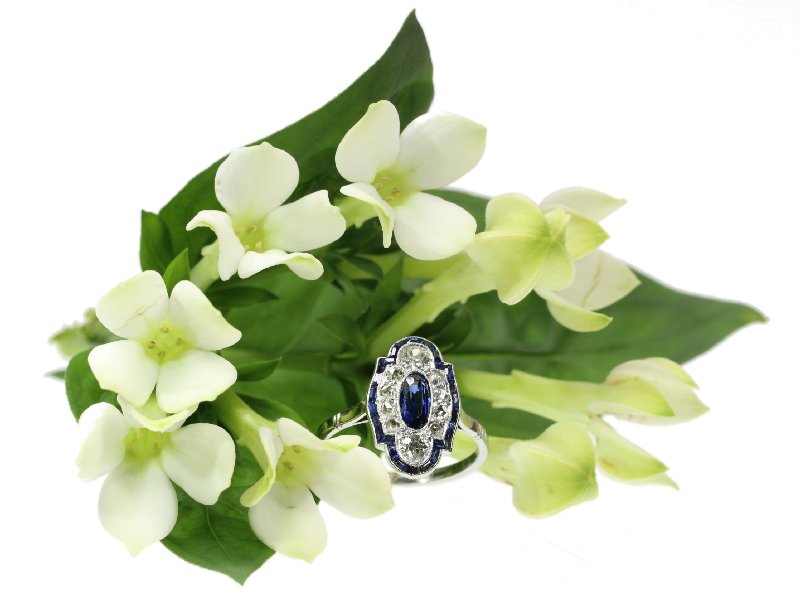 Click the picture to read about this high quality Art Deco ring. |
A clear case of oops!
Last week, an enthusiastic reader of our weekly newsletter handed us an idea. She had seen a mistake in our previous email and wrote us about it. We responded that it was "a clear case of oops".
She wrote us back again and came up with the idea to use "Clear cases or oops" as theme for future emails. As an example she gave the misunderstanding surrounding the "ruby" in the English crown. For centuries assumed to be a real ruby but turned out to be a spinel. Talking about "A clear case of oops"!
So, we will try to glean more 'OOPS' stories. In case you have one and want to share, let us know!
And thanks to Jenna for her contribution!
Spring season in The Garden of Adin
A ring of beauty is a joy forever!
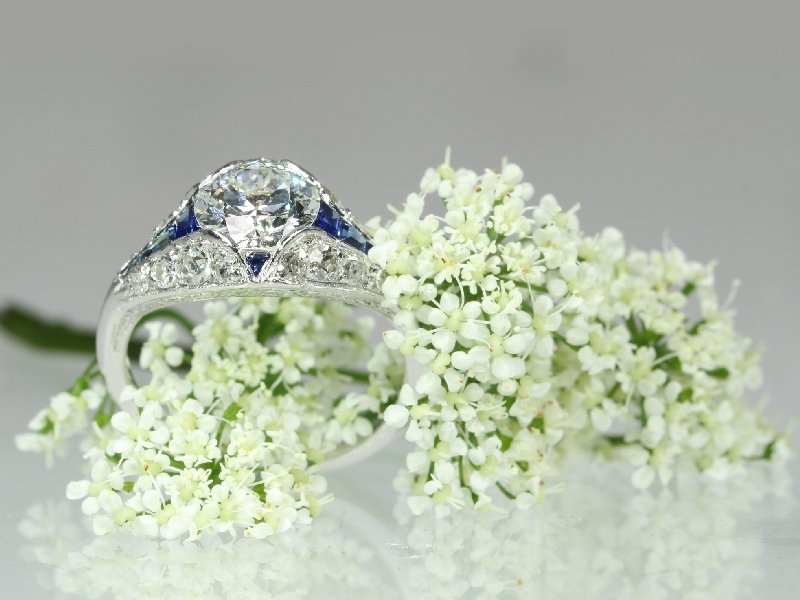 Click the picture to read about this high quality Art Deco ring. |
At the Adin website we have a fully worked out style overview of all Western countries of every era from 1620 till now.
And by clicking on each of those various styles, you will get an explanation of that style.
Click here to get there!
We sincerely hope you will enjoy the reading!
Spring season in The Garden of Adin
A ring of beauty is a joy forever!
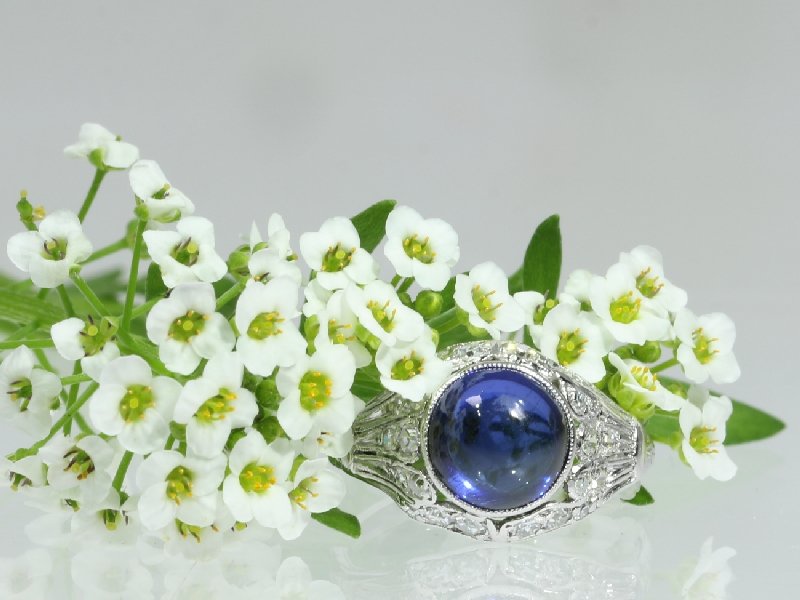 Click the picture to read about this platinum estate ring. |
To know something about antique and estate jewelry, one really has to dig into many (sometimes complex) factors.
Some of these are being touched upon in both the Antique Jewelry Lecture and in the
Adin's Jewelry Glossary at the Adin website.
Although we do not intend to delve into matters too deep, the information there will give a good idea on antique and estate jewelry and what it's all about.
We sincerely hope you will enjoy the reading!
Rocks & Roll !
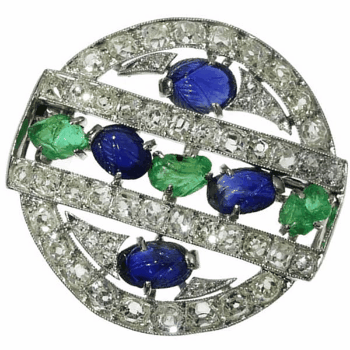 |
Tutti frutti, oh rutti
Tutti frutti, oh rutti
Tutti frutti, oh rutti
Tutti frutti, oh rutti
Tutti frutti, oh rutti
A wop Art Deco mop a lomp bom bom!
Jewelry like this, set with brightly colored gemstones polished as leaves, is called "Tutti Frutti jewelry". The first Tutti Frutti piece was a necklace commissioned by Queen Alexandra and designed by Pierre Cartier in 1901. Tutti Frutti jewel designs are considered to be a perfect mix of East and West because they are made up of brightly colored gemstones (like sapphires, rubies and emeralds) carved using Indian techniques and set in French platinum and diamond mountings.The style became extremely popular during the 1920's.
New In Our Assortment!
All in one!
Flower and relationship binders!
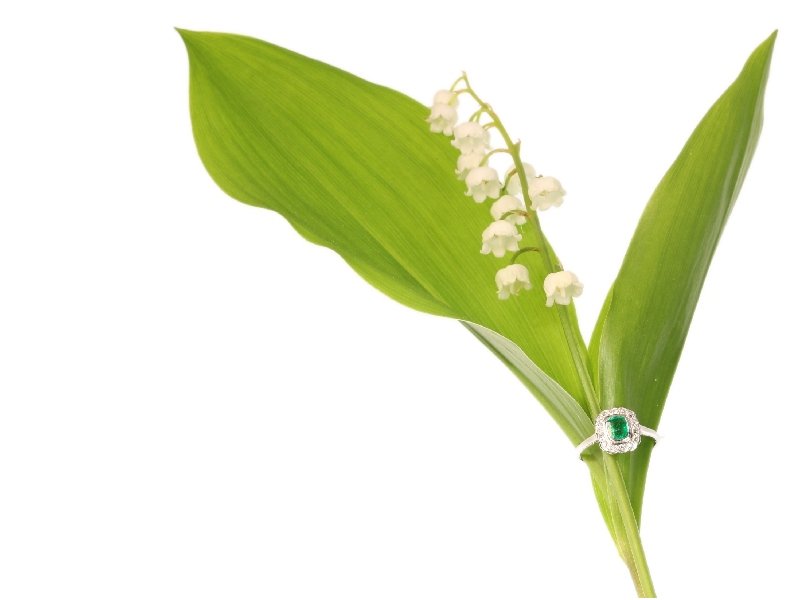 Click the picture to read more about this Art Deco ring. |
Suprise Mom!
Add something red to her breakfast!
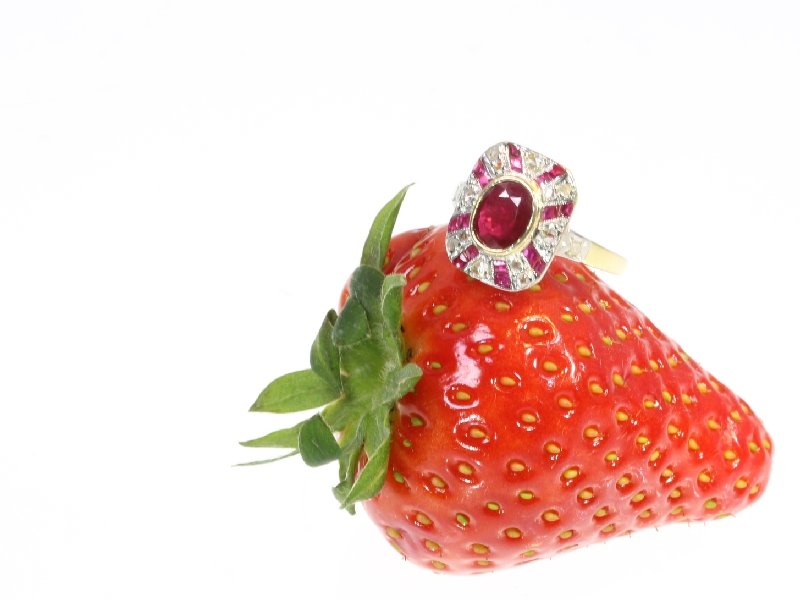 Click the picture to see all our jewelry with something red. |
Just imagine...
wearing earrings that are almost 300 years old!
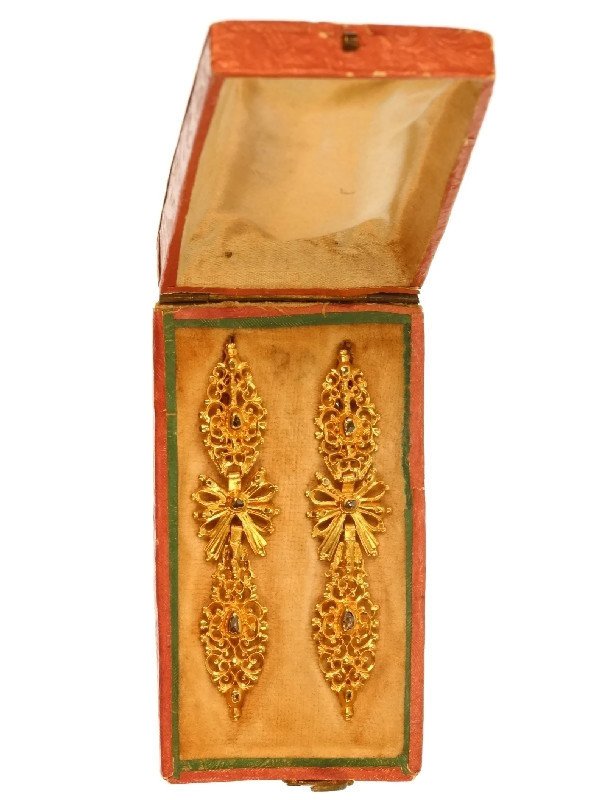 Click the picture to see and read more about these 18th Century gold and diamond earrings. |
In these 19,2K yellow gold Portuguese Rococo earrings from 1740 centres an adorable double bow dangling in between two marquise shaped flakes of a symmetrically pierced flourishing frills. With five rose cut diamonds dispersed in alignment over the entire jewel and two extra diamonds topping the bows on the left and right, you could relive a fragment of history and the era's romances in this warm openwork gold tucked in this original jewellery box.
Poetical spring in The Garden of Adin.
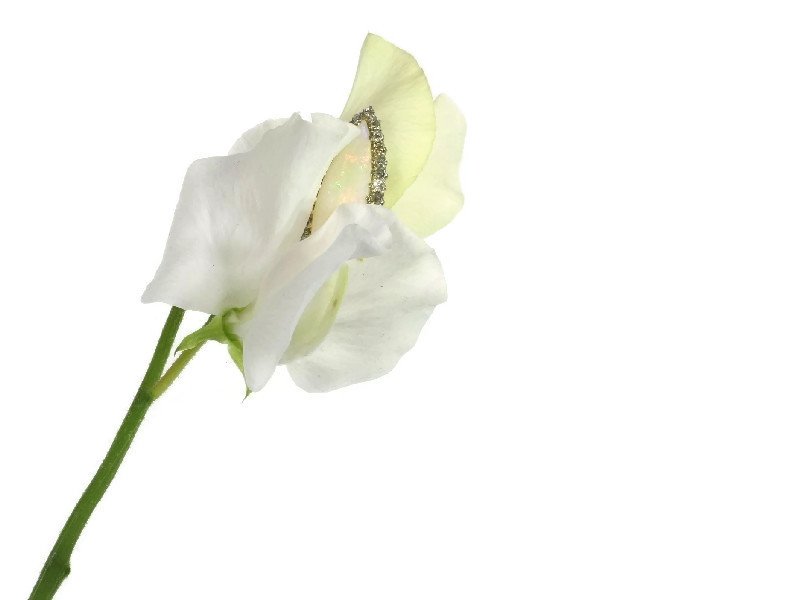 Click the picture to see and read more about this antique opal and diamond ring. |
A flower cannot blossom without sunshine,
and man cannot live without love.
Max Müller (1823-1900)
German-born philologist
Poetical spring in The Garden of Adin.
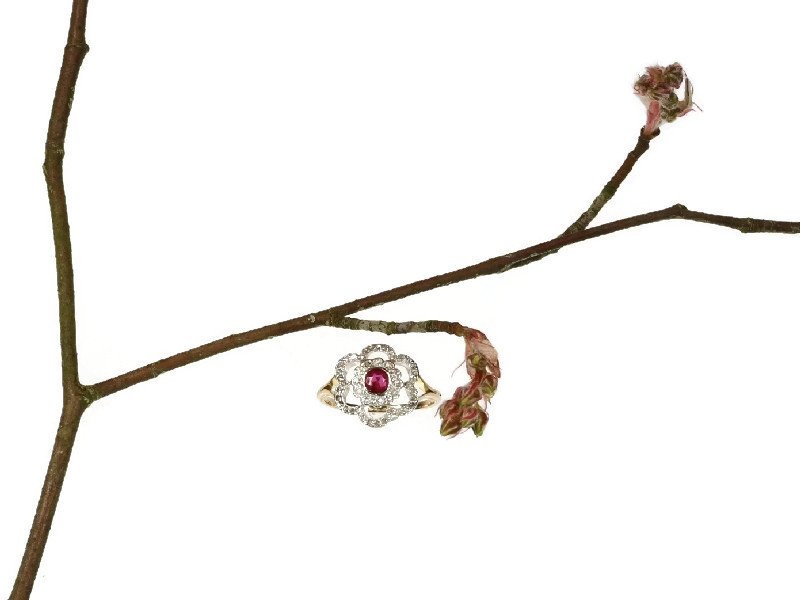 Click the picture to see and read more about this Antique ring. |
It is spring again.
The earth is like a child that knows poems by heart.
Rainer Maria Rilke (1875-1926)
one of the German language's greatest 20th century poets
Poetical spring in The Garden of Adin.
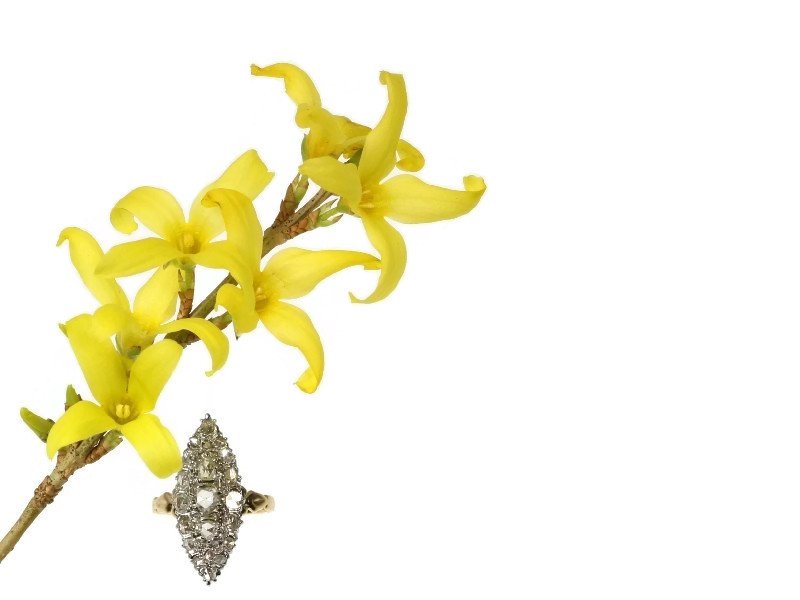 Click the picture to see and read more about this Antique ring. |
These gems have life in them
their colors speak
say what words fail of
George Eliot (1819–1880)
one of the leading writers of the Victorian era
Dew drops in The Garden of Adin.
Earth's liquid jewelry, wrought of air.
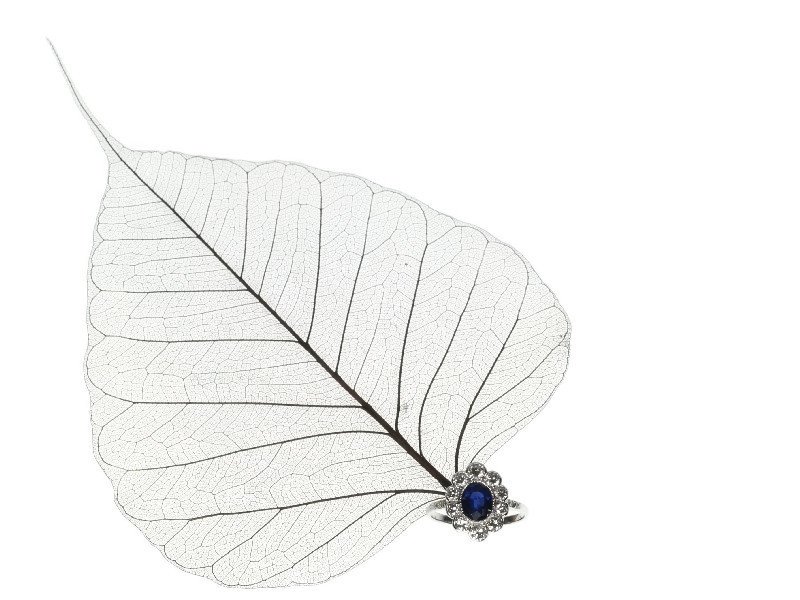 Click the picture to see and read more about this Lady Di Art Deco engagement ring. |
Dew...
Earth's liquid jewelry, wrought of air.
PHILIP JAMES BAILEY
English poet
(1816 - 1902)
Blue moon in The Garden of Adin.
With a dream in my heart...
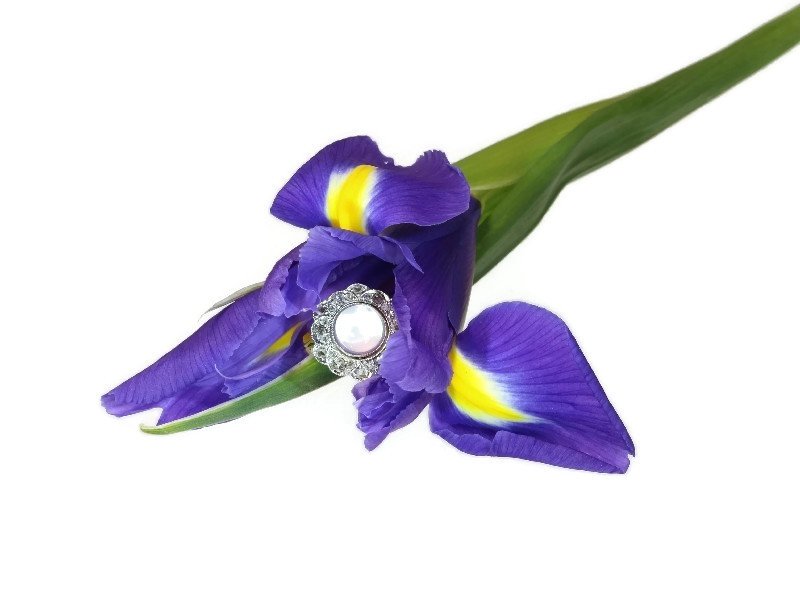 Click the picture to see and read more about this blue moonstone Art Deco ring. |
Blue Moon
Blue moon you saw me standing alone
Without a dream in my heart
Without a love of my own
Blue moon, you knew just what I was there for
You heard me saying a prayer for
Someone I really could care for
And then there suddenly appeared before me
The only one my arms will ever hold
I heard somebody whisper "Please adore me"
And when I looked, the moon had turned to gold!
Blue moon!
Now I'm no longer alone
Without a dream in my heart
Without a love of my own
"Blue Moon" is a classic popular song
written by Richard Rodgers and Lorenz Hart in 1934
Black, yellow and red in The Garden of Adin.
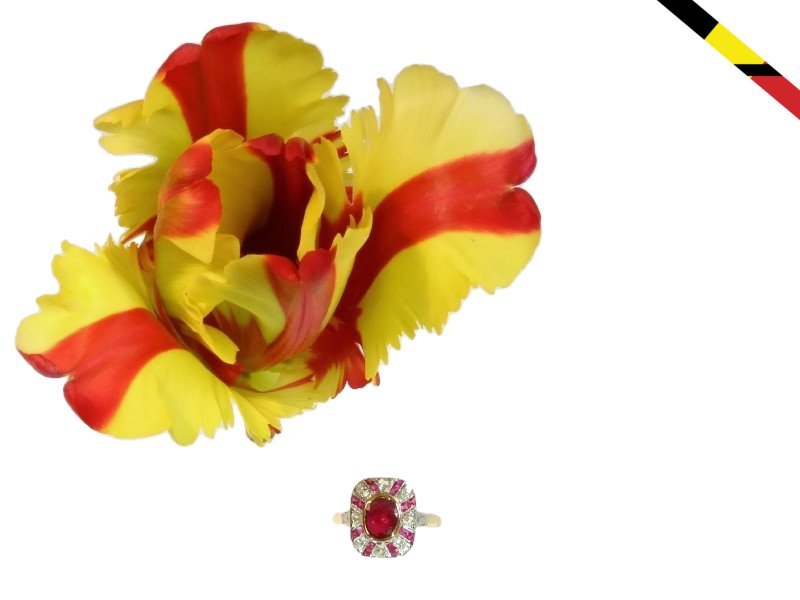 Click the picture to see and read more about this Art Deco ring. |
Antique Jewelry For A Balanced Life.
Blowing Bubbles In The Garden of Adin.
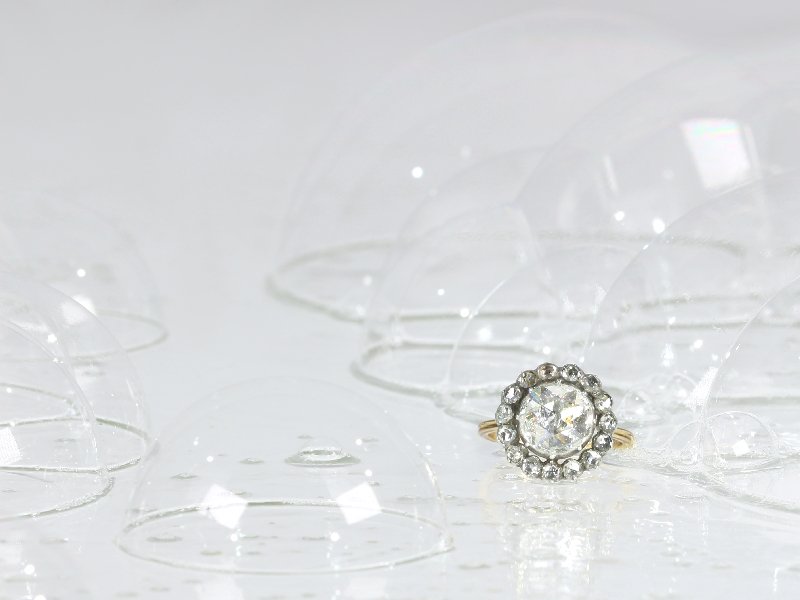 Click the picture to see and read more from this big rose cut diamond ring. |
As the centre of this gold Victorian cluster ring from 1870, the dazzling rose cut diamond set in silver on foil with a red gold domed engraved back is just as gorgeous in quality as it is grant in its diameter of 9,3mm (0.37 inch). Encircled by 15 rose cut diamonds encrusted in silver set on foil with a red gold back as well, no rose cut diamond has ever diffused more brilliance. A timeless grandeur as well as a cute sophistication is established in this one jewel.
Discover more jewelry suitable for wearing while blowing bubbles!
Antique Jewelry For A Balanced Life.
Attractive blossoms in The Garden of Adin.
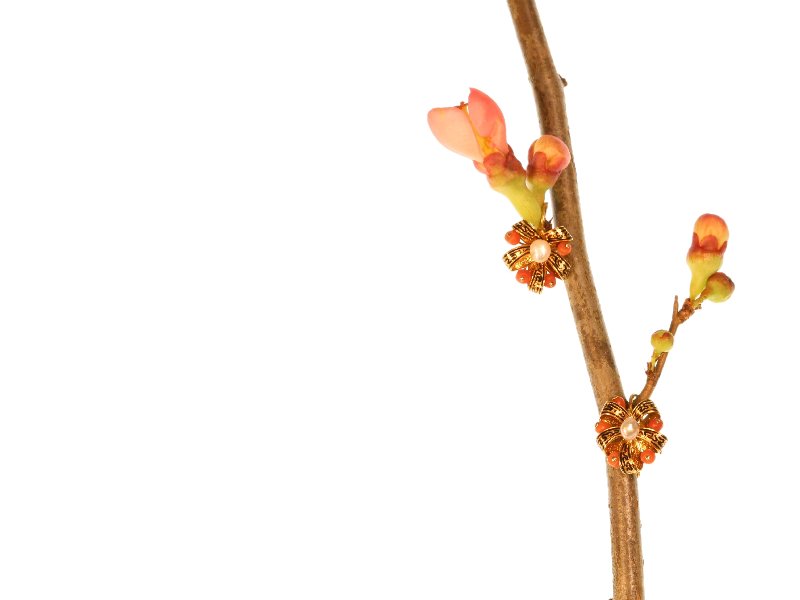 Click the picture to see and read more from this antique earrings. |
The darling style of these 18K yellow gold Victorian earrings from 1870 is all in their lush knot design tied up with a natural baroque pearl. Next to the five blood coral beads between each noose and the black enamel on the upper surface of these endearing jewels, the embellishments go even further in the engravings on the outside and inside of the gold ribbon just to remind you of the beauty of tying the knot.
Discover more blossoms in our entire collection of unique Victorian jewelry!
Antique Jewelry For A Balanced Life.
Poetry in The Garden of Adin.
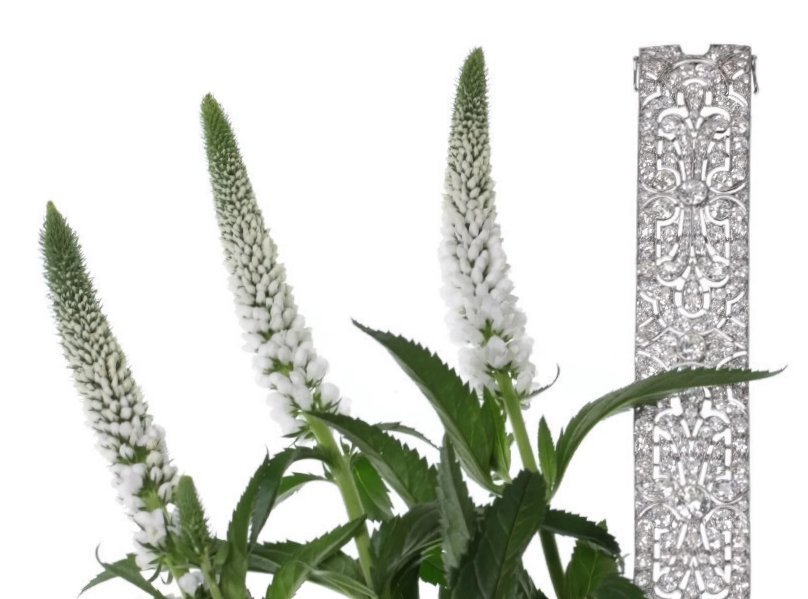 Click the picture to see and read more from this Art Deco bracelet. |
The Ancient Greek already knew!
If thou wilt make a man happy?
Add not unto his riches but take away from his desires.
If thou wilt make a woman happy?
Reach to your riches in The Garden of Adin to take away from her desires.
- Epicures -
Ancient Greek Philosopher 341–270 BC
(freely interpreted)
Antique Jewelry For A Balanced Life.
Get Zen in The Garden of Adin.
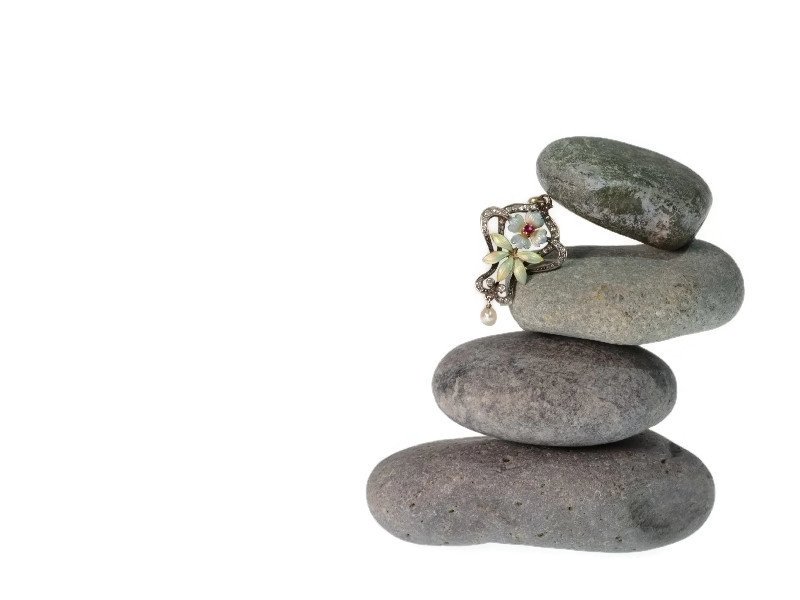 Click the picture to see and read more from this antique enameled pendant. |
Did you know?
Did you know that you can find an interesting lecture on antique jewelry at our website?
Gold growing on trees?
Scientists find small deposits in leaves
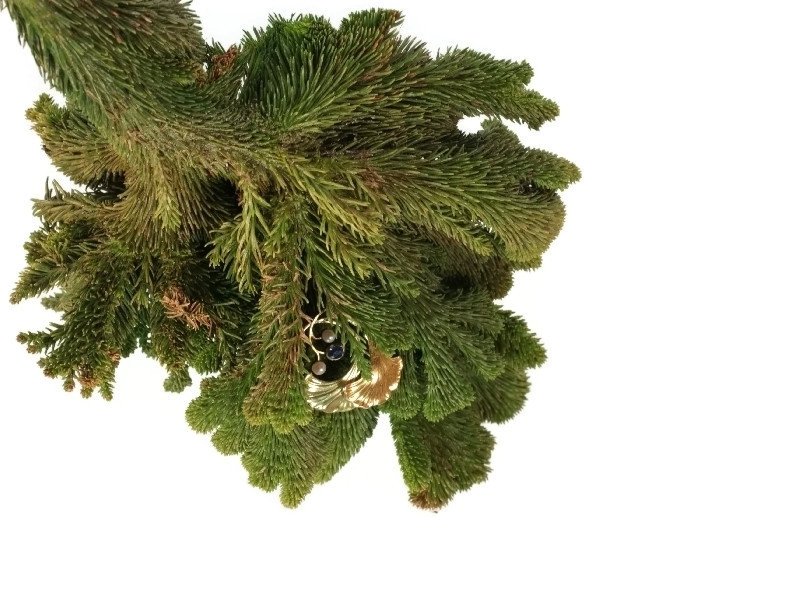 Click the picture to see and read more from this Art Nouveau brooch. |
Contrary to popular belief, gold does grow on trees. Scientists from the Adin Scientific and Industrial Research Organisation (ASIRO), have proved that the leaves of certain trees in The Garden of Adin contain interesting amounts of gold antique jewelry.
The scientists published their findings in the scientific journal "Nature & Antique Jewelry Communications" this week.
One of the authors of the paper, Adin's geochemist Dr Elkan Wijnberg, said some root systems dived down deeper than Art Nouveau. The tree acts “as a hydraulic style pump... drawing up the antique gold jewelry”, he said.
He also said that the discovery could offer a serious opportunity for antique jewelry exploration. We'll keep you informed!
New attraction in The Garden of Adin:
Twinkling Hanging Jewelry
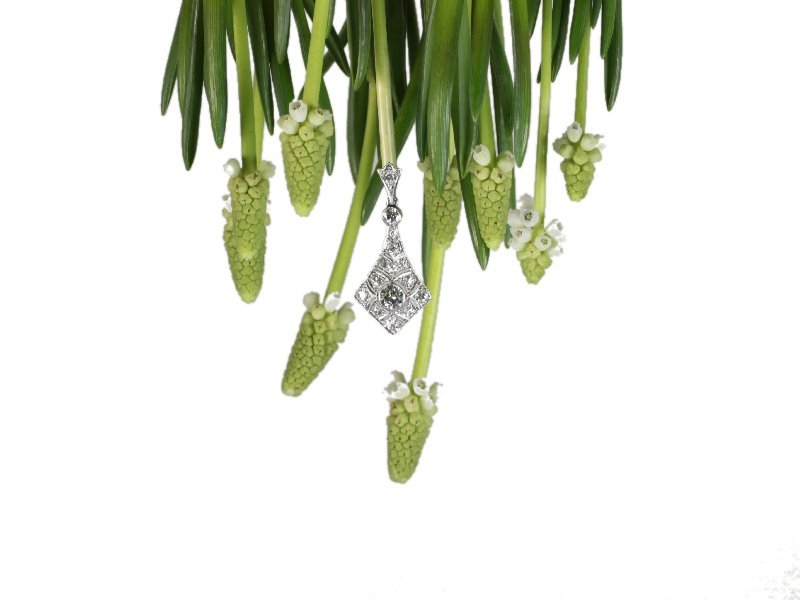 Click the picture to see and read more from this glimmer. |
The recent attraction in The Garden of Adin is a cave known for its population of twinkling hanging jewelry, called: Twinkling Delight or Adinius Orbis Luminosa. This species is found exclusively in The Garden of Adin. Each piece is around the size of an average pendant and very suitable for every day wear. Ages of over 100 years are not uncommon with this species.
There are organized tours that include a boat ride under the glimmers but due to the overwhelming success it is best to buy early.
Hide And Seek In The Garden of Adin.
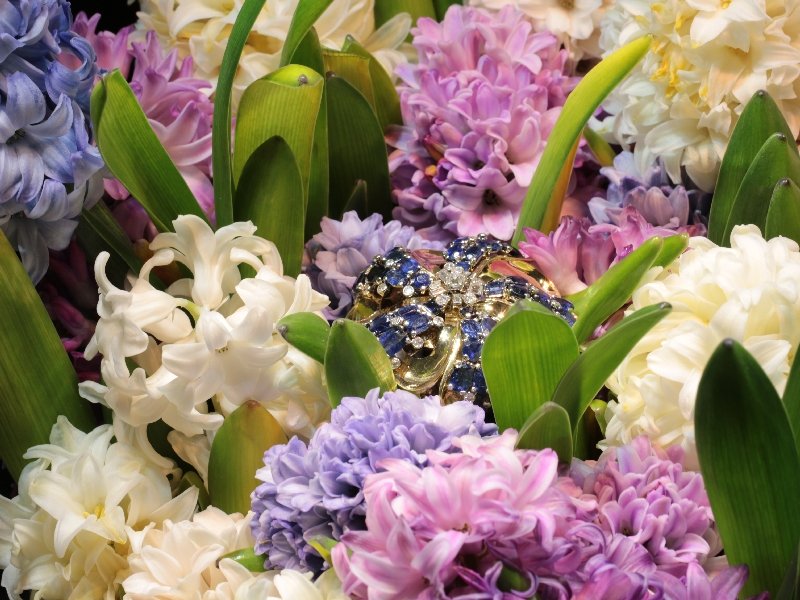 Click the picture to see and read more from this signed Cartier jewel. |
A stunning piece of jewelry made and signed by Cartier, Paris. A true representative of jewelry from the fifties of the twentieth century when all sorts of flowers were used as source of inspiration. These pieces were often abundantly decorated with precious stones.
Cartier - A leading French jewelry firm, founded in 1847, with its headquarters in Paris and branches in several major centres. Originally the firm made jewelry which attracted a prestigious clientele, including French royalty and the future Edward VII.
Hide And Seek In The Garden of Adin.
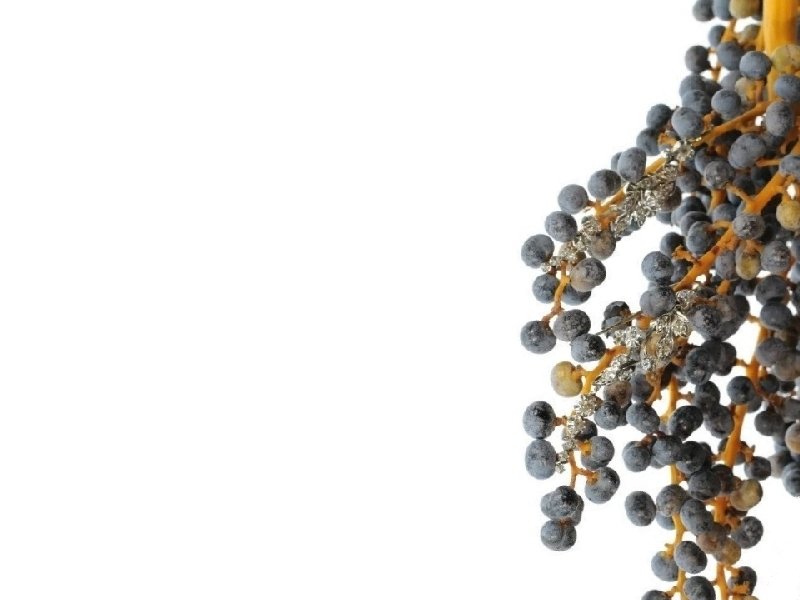 Click the picture to see and read more from these Victorian chandelier ear jewels. |
Adin's Recipes d'Amour
So many ways to spice up your life...
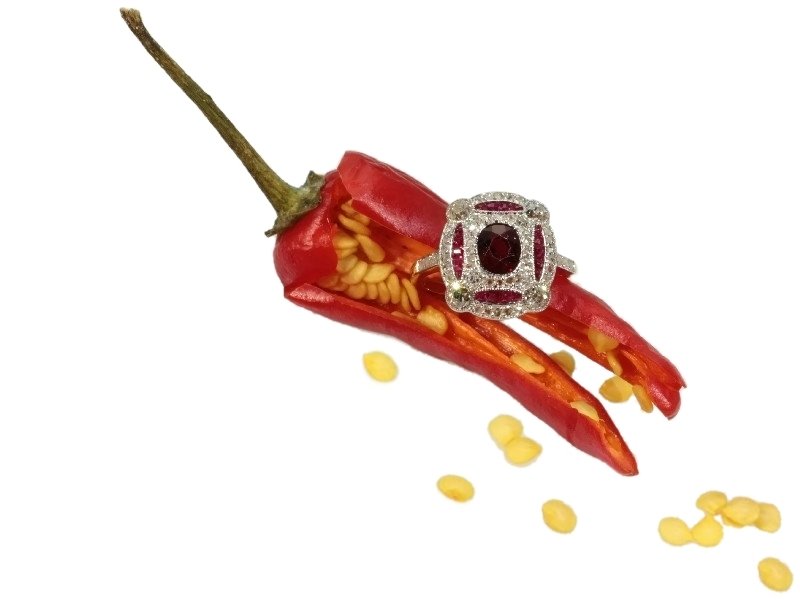 Click the picture to see and read more about this ring. |
Magic Beans!
Where else than in The Garden of Adin?
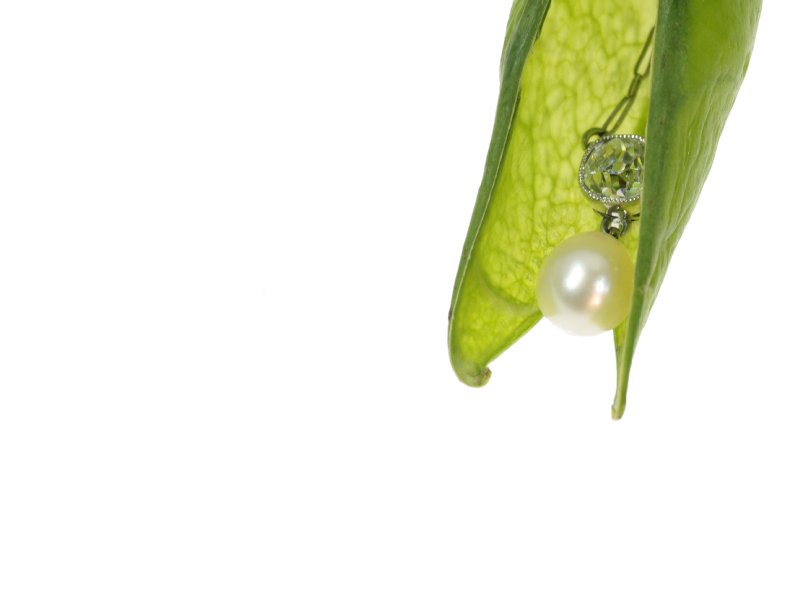 Click the picture to see and read about this pendant. |
A Bejeweled Bird Of Paradise
Where else than in The Garden of Adin?
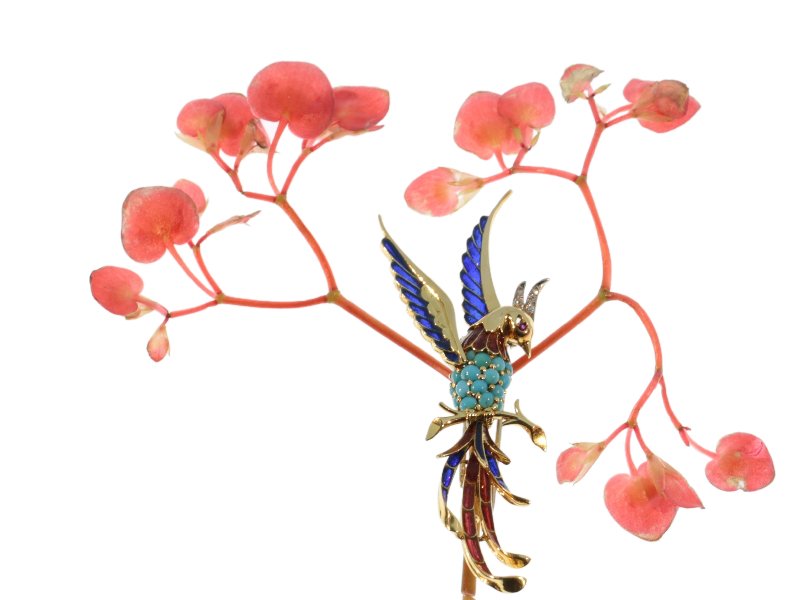 Click the picture to see and read more from this brooch. |
Just as spring's temperature is still present this mild winter, so is this bird of paradise still sitting on its branch here in the Garden of Adin.
The ancient Greek called it a Phoenix, the Egyptians a Bennu, the Persians a Huma... but however its cultural name, this bird of paradise symbolises resurrection within its own fire.
And how this Fifties brooch ignites in an incandescent inferno of vibrant gemstones and plique-à-jour enamel. Although this challenging technique with vitreous enamel in between the design's cells has mostly only been used during the Art Nouveau period, now an extra visible depth in the mythological meaning of this jewel's depiction is established by its coloured translucence flaring next to the diamonds, turquoises and ruby.
So better hurry to purchase before it flies off to its winter retreat, now Frost's cold is promised to come.
A 1500 Years Old Earring!
A true antiquity and still wearable!
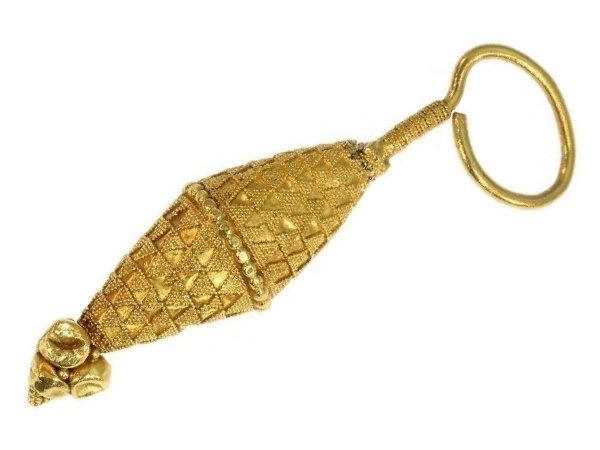 Click the picture to see this true antiquity. |
Being crafted between fourteen and seventeen centuries ago, this ancient ear pendant in at least 18K yellow gold is more of a precious artefact worthy of a showroom in a museum - just as a similar one is displayed in Germany - than being a customary antique jewellery piece.
Within this unique treasure, a triangular shape is repeated in its overall outline of two cones assembled at their bases as well as in the patterns of its typical Caucasian style field and cluster granulation. Having this in your possession, it is definitely more of an honour than a hazard to preserve and even wear this rare fragment of history.



